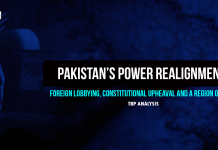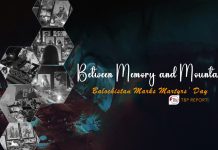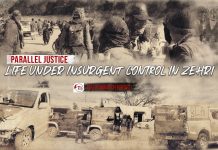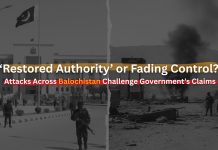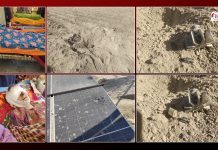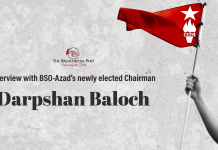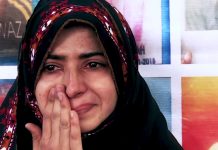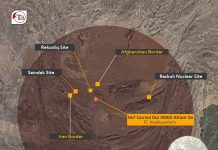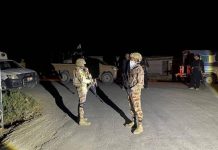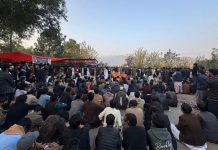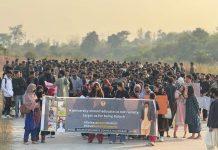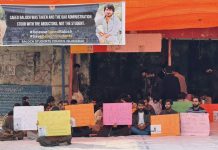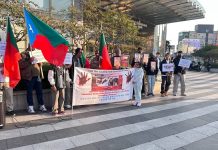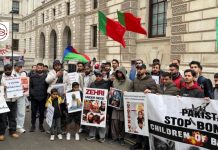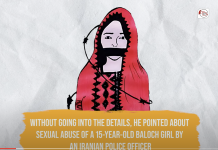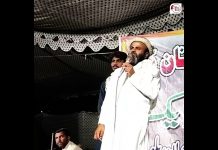Author: Darmankar
Introduction
Today, I witnessed a staggering video of a Baloch child, no older than five or six, defiantly confronting a police vehicle with palpable disdain. This single moment shattered the foundations of my psychological understanding. By all conventional wisdom, a child of such tender years should recoil in terror, instinctively fleeing from anything tied to the brutalities that scar their world. Yet here was the opposite—a bold, unyielding stance. Has the psychology of fear lost its grip on Baloch children, worn thin by its relentless overuse? Could this be a testament to an extraordinary resilience, forged deep within Baloch society, a defiance honed against the age-old weapon of state-induced dread? Or perhaps this is the new reality for these young souls — raised in a crucible where state oppression and Baloch resistance are the only constants they’ve ever known, rendering courage not an exception but their very nature?
In the vast, rugged expanse of Balochistan—a region that stretches across Pakistan, Iran, and Afghanistan—a profound and multifaceted drama unfolds, one where the human psyche becomes both a battleground and a bastion of hope. For decades, the Baloch people have endured a relentless campaign of fear, meticulously orchestrated by state authorities, particularly in Pakistan, through tools like systemic violence, enforced disappearances, cultural erasure, and disinformation. This pervasive terror, designed to crush spirits and silence voices, has instead ignited an extraordinary resilience, a force that has turned the oppressed into tenacious agents of resistance. This article delves deeply into the psychological and psychoanalytical dimensions of this struggle, exploring how fear has been weaponized as a form of psychological warfare, how it has precipitated a humanitarian crisis, and how the Baloch—led by luminaries like Dr. Mahrang Baloch, Sammi Deen Baloch and other Baloch human rights activists and political leaders—have transformed this terror into a powerful movement for justice and resistance. By drawing parallels with historical resistance movements worldwide, it also charts potential pathways toward healing, illuminating the indomitable capacity of the human spirit to reclaim agency amidst profound suffering.
The Mechanics of Fear and Psychological Warfare
Fear in Balochistan is not a fleeting emotion but a deliberate and pervasive instrument of control, rooted in both primal instincts and sophisticated strategies of domination. Enforced disappearances, a grim hallmark of this oppression, echo the haunting legacy of Argentina’s “Desaparecidos” during the Dirty War (1976–1983), where an estimated 30,000 individuals vanished without a trace. In Balochistan, this tactic leaves families trapped in a torturous limbo, grappling with what psychologist Pauline Boss terms “ambiguous loss” —grief without closure, where the absence of definitive knowledge about a loved one’s fate prevents the natural progression through mourning (Boss, 1999). The Pakistani state’s military apparatus amplifies this dread through extrajudicial killings, torture, and the macabre practice of dumping mutilated bodies in desolate areas, creating a chronic state of what Sigmund Freud might call “anxiety of the real” —a visceral fear anchored in tangible, external threats rather than internal psychological conflicts (Freud, 1920).
Psychoanalytically, this campaign of terror serves a sinister dual purpose. It fractures the collective psyche of the Baloch community, sowing seeds of mistrust, isolation, and despair while simultaneously positioning the state as an omnipotent, punitive superego—an internalized authority figure that relentlessly punishes dissent and enforces compliance (Freud, 1923). Beyond physical violence, psychological warfare unfolds through disinformation and propaganda, akin to the Soviet Union’s narrative dominance in Eastern Europe or China’s control over Tibet and Xinjiang. The Baloch struggle is smeared in state-controlled media as terrorism or foreign agitation rather than a legitimate cry for rights and autonomy, fostering cognitive dissonance—a psychological tension where individuals must reconcile conflicting truths, often leading to confusion or reluctant submission (Festinger, 1957).
Cultural suppression further deepens this warfare, mirroring the cultural genocide inflicted upon Indigenous peoples in North America or Australia. The systematic dismantling of Baloch language, traditions, and history aims to sever the people from their roots, resulting in what Erik Erikson described as “identity diffusion” —a fragmented sense of self that undermines resistance by disconnecting individuals from their heritage (Erikson, 1968). Meanwhile, divide-and-conquer tactics, reminiscent of the British Raj’s exploitation of India’s religious and caste divisions, exacerbate tribal rivalries and sectarian tensions among the Baloch, as explained by social identity theory, which highlights how intergroup conflict can fragment unity and redirect anger inward rather than toward the oppressor (Tajfel & Turner, 1979). Collectively, these strategies cultivate “learned helplessness,” a state where the oppressed internalize their powerlessness, leading to depression, anxiety, and a breakdown of communal bonds (Seligman, 1975).
Resilience: Transforming Fear into a Collective Force
Yet, when fear saturates every facet of life—when every household mourns a missing son, brother, or father—it transcends individual suffering to become a shared experience, a unifying force that defies its intended purpose. In Balochistan, resilience is not a passive endurance but an active, vibrant defiance, fueled by the very terror meant to paralyze. Psychologist Viktor Frankl, reflecting on his survival of the Holocaust, argued that finding meaning in suffering can transform victims into victors (Frankl, 1946); for the Baloch, this meaning lies in their unwavering pursuit of justice, dignity, and self-determination. Psychoanalytically, this shift represents a bold rebellion against the oppressive superego imposed by the state. Rather than internalizing subjugation, the Baloch externalize their rage, grief, and hope, channeling these emotions into a structured resistance—a process akin to the “working through” of trauma, where repressed feelings are confronted, integrated, and woven into a narrative of survival and empowerment.
The Baloch Yakjehti Committee (BYC), under the leadership of Dr. Mahrang Baloch and the collective strength of all Baloch men and women, stands as a testament to this transformation. Dr. Mahrang, a medical doctor turned activist, embodies resilience forged in the crucible of personal tragedy: her father, Abdul Ghaffar Lango, was abducted in 2009 and found dead in 2011, his body bearing the scars of torture, while her brother vanished in 2017, another victim of enforced disappearance. This plunge into fear and loss could have broken her, yet it ignited an unyielding resolve. Psychoanalytically, her journey reflects a mastery of Freud’s “repetition compulsion”—the impulse to revisit trauma not as a helpless victim but as a survivor determined to rewrite the story (Freud, 1914). As a leader, she has spearheaded peaceful yet powerful protests, such as the 2023 Long March from Turbat to Islamabad, demanding an end to disappearances and killings.
Dr. Mahrang’s leadership is not solitary; it is amplified by the courage of all Baloch women, who have emerged as a formidable force in this struggle. In a traditionally patriarchal society, their participation—marching alongside Mahrang, raising their voices, and defying cultural constraints—marks a revolutionary shift. This collective action reflects Carl Jung’s concept of the “shadow”—the hidden strength and defiance awakened by oppression (Jung, 1959)—and a rejection of the internalized oppression of the superego. By stepping into the public sphere, all Baloch women, alongside Dr. Mahrang, assert their agency, rewriting their collective identity and inspiring a movement that transcends gender and tribal divides. Their resilience has withstood relentless state efforts to silence them—arrests, harassment, travel bans—and has turned fear into a rallying cry, proving that when confronted head-on, terror loses its grip.
Historical Parallels: A Global Tapestry of Resistance
The Baloch struggle is not an isolated anomaly but part of a global lineage of resistance against oppression. The African National Congress (ANC) in South Africa during apartheid offers a striking parallel: the regime’s massacres, detentions, and torture sought to instill fear, yet leaders like Nelson Mandela harnessed collective suffering into a resilient movement that toppled an unjust system—a triumph of the ego over an overbearing superego. Similarly, India’s independence movement against British colonial rule saw atrocities like the Jallianwala Bagh massacre radicalize figures such as Mahatma Gandhi and Bhagat Singh, whose nonviolent and revolutionary strategies, respectively, mobilized millions. This awakening aligns with Jung’s individuation—a collective realization of selfhood that defies domination (Jung, 1959).
The U.S. civil rights movement, led by Martin Luther King Jr., and the Arab Spring, propelled by digital solidarity, further illustrate how psychological warfare can backfire, fostering collective efficacy—the shared belief in a community’s power to effect change (Bandura, 1997). In Balochistan, this historical resonance is palpable in the persistent protests and the global outreach enabled by the digital age, where the Baloch counter state propaganda and build international support, echoing the Tibetan and Kurdish struggles for recognition.
The Humanitarian Toll and Intergenerational Impact
The humanitarian crisis in Balochistan magnifies the stakes of this struggle. With thousands killed or missing, widespread poverty, and minimal access to education or healthcare, the region bears the scars of fear-driven oppression. Psychologically, this fosters “historical trauma,” a legacy passed down through generations, much like the experiences of Native American communities or descendants of Holocaust survivors (Bowlby, 1988). Stories of loss and fear permeate every household, disrupting secure attachments and perpetuating distress across parenting styles and communal life. For the youth, growing up under this shadow mirrors the disenfranchisement seen among Palestinian or Northern Irish youth during The Troubles, where oppression breeds either radicalization or pervasive hopelessness, as Frantz Fanon’s analysis of colonized psyches suggests (Fanon, 1963). Yet, the BYC’s activism, led by Dr. Mahrang Baloch and all Baloch women, counters this despair, spotlighting not only political grievances but the profound human cost—a clarion call for global attention.
Pathways to Healing and Restoration
Healing Balochistan demands more than political resolutions; it requires a holistic approach to mend psychological wounds, rebuild identity, and restore hope:
● Tailored services, inspired by post-conflict models in Bosnia or Cambodia, must address ambiguous loss and collective trauma.
● International Initiatives to preserve Baloch language, music, and traditions—akin to Indigenous revitalization efforts globally—can counteract cultural suppression, strengthening identity and pride.
● Incorporating Baloch history and rights into curricula, as seen in post-apartheid South Africa, can rebuild self-esteem and foster a sense of agency among the young.
● Reconciliation processes, modeled on South Africa’s Truth and Reconciliation Commission, can facilitate dialogue, acknowledge wrongs of illegal occupation and oppression, and heal communal rifts.
Conclusion
In Balochistan, fear has been a double-edged sword—a meticulously crafted tool of psychological warfare that, when stretched to its breaking point, becomes the oppressed’s greatest ally. Through psychological resilience, psychoanalytical defiance, and the leadership of Baloch political and human rights groups, the Baloch people have turned terror into a catalyst for resistance, echoing the triumphs of historical movements like the ANC and the civil rights era. Their story is a testament to a universal truth: when fear meets resilience, the oppressed do not merely endure—they rise, reclaiming their agency and forging a path toward liberation.
Healing this fractured society will require global solidarity, psychological recovery, and a revitalized cultural identity, ensuring that Balochistan’s narrative evolves from one of suffering to one of triumph over tyranny. As Baloch men and women lead the charge, they illuminate a future where freedom is not just a distant dream but a lived reality, won through the courage to confront and transcend fear.
Disclaimer: The views and opinions expressed in this article are those of the author and do not necessarily reflect the official policy or position of The Balochistan Post or any of its editors.

